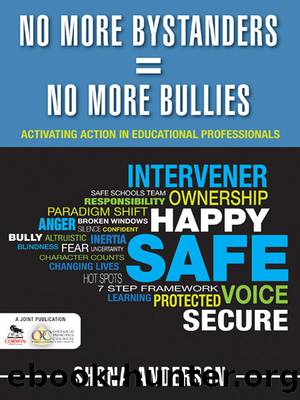No More Bystanders = No More Bullies by Anderson Shona;

Author:Anderson, Shona;
Language: eng
Format: epub
ISBN: 1051625
Publisher: Corwin Press
Published: 2011-01-11T00:00:00+00:00
Sharing of information:
Avoiding the label:
MORE MATH: THE 2-BY-10 STRATEGY
The Pareto principle is a good strategy to make the number of targeted students more manageable for staff. Highlighting those students who need an extra set of eyes on them helps staff move from being bystanders to taking action because they have a better idea of whom to observe. What the numbers up until this point donât tell us is how to make a difference.
It is essential to remember that for each of the numbers you wrote down in the previous section, there is a child in need. Whether that child is 6 or 16, he or she is still a child, and our job is to help that student make the best choices possible. It can be easy in our educational world, which is overrun with data, to forget that each number has a face and a story and deserves to be treated as more than just a statistic.
The 2-by-10 strategy is a way to make a difference using the numbers. The strategy was first introduced by Susan Nolen and her colleagues from the University of Washington (2007) through her research focused on student teachers; Nolen challenged teachers to spend 30 minutes outside of class connecting with students who are at risk. The work of Wlodkowski (1999) further simplified the idea of taking the time to connect with students by saying that the 30 minutes do not have to be consecutive. Just 2 minutes a day for 10 or 15 days can achieve the same result of a deeper understanding of the student and the beginnings of a connection that can change the trajectory of the studentâs educational future. Thus, we arrive at the 2-by-10 strategy, or 2 minutes a day for 10 days.
Iâm not naïve enough to think that 30 minutes is enough to make a difference for every student or that every student is even open to connecting with an adult in school. The 2-by-10 strategy does not mean that you sit down for one heart-to-heart and think that everything will be better. Rather it means that by communicating in small, manageable increments, educational professionals can start to make connections with at-risk students. This strategy also does not mean that you do not connect with all of the students in your class or school. It just means that by giving a student an extra âhelloâ or having a brief and seemingly superficial encounter in the hallway, you can begin to start something with an at-risk student. Those students may begin to feel a connection with you on a personal level, which may help them see that an adult in their world cares about them. Even in the overworked world of educators, finding two minutes is possible, and that is the true beauty of this philosophy. You donât have to convince your staff to be counselors and have deep and involved sessions with troubled kids. By making such connections manageable, this strategy motivates educators to take action.
As a school administrator,
Download
This site does not store any files on its server. We only index and link to content provided by other sites. Please contact the content providers to delete copyright contents if any and email us, we'll remove relevant links or contents immediately.
Macmillan Primary Grammar 2 Pupil's Book by Unknown(380)
Figuring Out Fluency in Mathematics Teaching and Learning, Grades K-8 by Jennifer M. Bay-Williams & John J. SanGiovanni(345)
The Principal's Guide to Curriculum Leadership by Sorenson Richard D.;Goldsmith Lloyd M.;Mendez Zulma Y.;Maxwell Karen T.;(266)
English Grammar Practice--The Noun by Roxana Nastase(229)
Learning from Accidents 3rd ed by Trevor Kletz (2001)(226)
Harnessing Technology for Deeper Learning by Scott McLeod(215)
Text-Dependent Questions, Grades K-5 by Douglas Fisher & Nancy Frey & Heather Anderson & Marisol Thayre(212)
A Guide to Curriculum Mapping by Hale Janet A.;(202)
English Language Program Administration by Unknown(199)
Deep Change Leadership by Reeves Douglas;(190)
How to Do Everything with Google Tools by Unknown(188)
The Grammar Teacher's Activity-a-Day by Jack Umstatter(179)
The Power of SMART Goals by Conzemius Anne;O'Neill Jan; & Anne Conzemius(177)
Beyond the RTI Pyramid by Bender William N.;(158)
Aligning and Balancing the Standards-Based Curriculum by Squires David A.;(156)
Using Data to Close the Achievement Gap by Johnson Ruth S.;(156)
Using Equity Audits to Create Equitable and Excellent Schools by Skrla Linda E.;McKenzie Kathryn B.;Scheurich James Joseph;(151)
Differentiated Instructional Strategies for the Block Schedule by Gregory Gayle H.;Herndon Lynne E.; & Lynne E. Herndon(145)
You've Got to Reach Them to Teach Them by Schreck Mary Kim; & Schreck(140)
